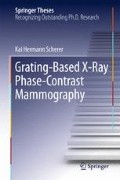Abstract
In the year 1895, Wilhelm Röntgen discovered a novel electromagnetic radiation while investigating cathode rays, which he signified with an “X” for being of yet unknown type [1]. By accident, he found that the latter yield the capability of penetrating black paper which is typically opaque for visible light. This observation prompted him to repeat the experiments with optically intransparent matter. Utilizing a photographic plate, Röntgen managed to retrieve the first radiography of a human hand and phalanges, by which he unwittingly laid the foundation for all modern X-ray applications, including medical diagnostics, non-destructive testing, security screening and fundamental research. For a very long time, X-rays were solely utilized to reveal high density-fluctuations within a sample, by simply mapping differences in the transmission of photons through the investigated specimen, using photosensitive plates and later electronic detectors.
Ich fand ganz zufällig, dass die Strahlen schwarzes Papier durchdringen.
Wilhelm Röntgen
Access this chapter
Tax calculation will be finalised at checkout
Purchases are for personal use only
References
Novelline, R. (1997). Squire’s fundamentals of radiology. Cambridge: Harvard University Press.
Quekett, J. (1852). A Practical treatise on the use of the microscope. London: H. Bailliere.
Wheeler, R. (2010). Micrograph of Whatman lens tissue paper. Bright/Dark-field illumination. http://de.wikipedia.org/wiki/File:Paper_Micrograph_Bright/Dark.png.
Zernike, F. (1942). Phase-contrast, a new method for microscopic observation of transparent objects. Physica, 9, 974–986.
Zernike, F. (1955). How I discovered phase contrast. Science, 121, 345–349.
Bonse, U., & Hart, M. (1965). An X-ray interferometer. Applied Physics Letters, 6, 155–157.
Davis, T., et al. (1995). Phase-contrast imaging of weakly absorbing materials using hard X-rays. Nature, 373, 595–598.
Chapman, L., et al. (1997). Diffraction enhanced X-ray imaging. Physics in Medicine and Biology, 42, 2015–2025.
Snigirev, A., et al. (1995). On the possibility of X-ray phase contrast microimaging by coherent high-energy synchrotron radiation. Review of Scientific Instruments, 66, 5486–5492.
Wilkins, S., et al. (1996). Phase-contrast imaging using polychromatic hard X-rays. Nature, 384, 335–338.
David, C., Nöhammer, B., & Ziegler, E. (2002). Differential X-ray phase contrast imaging using a shearing interferometer. Applied Physics Letters, 81, 3287–3290.
Takeda, T., et al. (2002). Vessel imaging by interferometric phase-contrast X-ray technique. Circulation, 105, 1708–1712.
Bevins, N., Zambelli, J., Li, K., Qi, Z., & Chen, G. (2012). Multicontrast X-ray computed tomography imaging using Talbot-Lau interferometry without phase stepping. Medical Physics, 39, 424–428.
Pfeiffer, F., Weitkamp, T., Bunk, O., & David, C. (2006). Phase retrieval and differential phase-contrast imaging with low-brilliance X-ray sources. Nature Physics, 2, 258–261.
Pfeiffer, F., Kottler, C., Bunk, O., & David, C. (2007). Hard X-Ray phase tomography with low-brilliance sources. Physics Review Letters, 98, 108105.
Pfeiffer, F., et al. (2008). Hard-X-ray dark-field imaging using a grating interferometer. Nature Materials, 7, 134–137.
Yaroshenko, A., et al. (2013). Pulmonary emphysema diagnosis with a preclinical small-animal X-ray dark-field scatter-contrast scanner. Radiology, 269, 427–433.
Eggl, E., et al. (2015). Prediction of vertebral failure load by using X-ray vector radiographic imaging. Radiology, 275, 553–561.
Hetterich, H., et al. (2014). Phase-Contrast CT: qualitative and quantitative evaluation of atherosclerotic carotid artery plaque. Radiology, 271, 870–878.
Bech, M., et al. (2013). In-vivo dark-field and phase-contrast X-ray imaging. Scientific Reports, 3, 3209.
Koehler, T., et al. (2015). Slit-scanning differential X-ray phase-contrast mammography: proof-of-concept experimental studies. Medical Physics, 42, 1959–1965.
Author information
Authors and Affiliations
Corresponding author
Rights and permissions
Copyright information
© 2016 Springer International Publishing Switzerland
About this chapter
Cite this chapter
Scherer, K.H. (2016). Preamble. In: Grating-Based X-Ray Phase-Contrast Mammography. Springer Theses. Springer, Cham. https://doi.org/10.1007/978-3-319-39537-1_1
Download citation
DOI: https://doi.org/10.1007/978-3-319-39537-1_1
Published:
Publisher Name: Springer, Cham
Print ISBN: 978-3-319-39536-4
Online ISBN: 978-3-319-39537-1
eBook Packages: Physics and AstronomyPhysics and Astronomy (R0)

